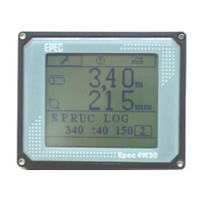7.15 Overrunning Distance (19)
− The overrunning distance is the same for all tree species.
− If the overrunning method is not 0, this setting has an influence.
− Setting range 0 – 255 cm.
NOTE!
The overrunning distance is always at least 2 x the expected braking
distance when reversing, if an overrunning method has been selected.
The overrunning cannot be eliminated by setting an overrunning
distance of 0, but the overrunning method 0 (no overrunning) must be
selected.
7.16 Number of Trials in Automatic Feed (Seeking the
measure) (20)
− By automatic feed, measuring equipment selects the feed method
(fast speed, low speed, search pulses).
− If the desired length is not reached directly, measuring equipment
tries again based on a new distance, with a new feed method, to find
the length as many times as the number of trials indicates.
− If the feed has got completely stuck, it should be interrupted with the
manual feed key.
− The number of length searching trials can be set. A suitable number
is appr. 10.
− Setting range 0 – 255.
7.17 Expected Braking Distances (21 – 25)
− Measuring equipment checks the real braking distance after each
stop and corrects the expected braking distance based on this new
information. Thus, the expected braking distance is automatically set
to the correct value. The braking distance is the distance that the tree
moves after the feed valves are not more open.
− The largest single correction of the expected braking distance (setting
21, range 0 – 255 mm) can be limited by setting the single correction
to zero. Then the measuring equipment will not correct the expected
braking distances, but the set values remain. This is necessary for
instance when handling difficult trees, since in such situations the
automatic system has difficulties to learn the expected braking
distance.
− The expected braking distances can be pre-set separately for
different feed methods.

